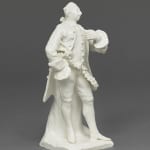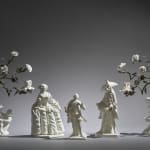


An Extremely Rare and Important Bow White Figure of David Garrick, possibly in the role of Archer, Circa 1750
Further images
An Extremely Rare and Important Bow White Figure of David Garrick, possibly in the role of Archer in George Farquhar’s Beaux Stratagem, stands in a theatrical contrapposto pose on a square base. He wears a flared coat over a buttoned waistcoat with tufted edge, and shirt with ruffled cuffs. He has a tricorn hat tucked under his right arm, right hand in breeches worn over stockings with incised decoration and buckled shoes. His left hand holds open his coat. He wears a cravat around his neck and ribbon tied wig on his head.
The play Beaux’ Stratagem was first produced in London 1707, where the plot follows the characters Archer and Aimwell as the beaux who have lost their fortunes. To recover their losses, they devise a stratagem to wed heiresses. David Garrick was an eminent actor, playwright, and theatre manager. His performances were well received for his realistic portrayals compared to the earlier declamatory style delivered by actors such as Colley Cibber and James Quin, where bodily action was absent or minimal. In David Garrick: A Critical Biography, the authors George M. Kahrl and George Winchester Stone describe Garrick’s friendships and connections across members of society from ‘the churchman, the brewer and publisher, the artist, the lawyer, several doctors, the bankers and the country gentlemen…with instincts for collecting books and pictures all shared interests in Garrick’s profession.’
As a successful theatre manager, he introduced new lighting, stage setting, and costumes from Paris to London and was the subject of over four hundred portraits, drawings, and engravings by artists such as Hogarth, Reynolds, and Gainsborough. As he inspired artists, so too was his craft inspired by art, as demonstrated in his Essay on Acting, dated 1744, when describing how his character Abbel Drugger ‘will unavoidably give himself a Tremor in the Knees and if his Fingers, at the same time, seem convuls’d, it finishes the completest low Picture of Grotesque Terror that can be imagin’d by a Dutch painter.’
See the Jessie and Sigmund Katz Collection in the Museum of Fine Arts, Boston (1988.599) for a similar figure decorated in overglaze enamels.
See the Victoria and Albert Museum, London (S.435-1997) for an print engraving by Robert Sayer (1724-1794) depicting Garrick in the role of Archer, dated 1771
See the Walker Art Gallery, Liverpool (634) for a painting by William Hogarth (1697-1764), David Garrick as Richard III, c. 1745. See the National Portrait Gallery, London (NPG 1167) for a profile portrait of David Garrick by Johan Zoffany (1733-1810) dated 1763.
Literature
See Raymond C. Yarbrough, Bow Porcelain and the London Theatre (Hancock, 1996), Cat. 6, p. 38.Join our mailing list
* denotes required fields
We will process the personal data you have supplied in accordance with our privacy policy (available on request). You can unsubscribe or change your preferences at any time by clicking the link in our emails.


